How To Change Direct Map To 2 Way Associative Cache Vivado
Installing Vivado, Xilinx SDK, and Digilent Board Files
Introduction
This guide will show the process of installing and configuring the Vivado development environment, used for developing projects to run on Digilent FPGAs. In addition to the installation, Vivado will be pointed at Digilent's board support files, which are used to make the process of creating a new project significantly faster. In addition, the board files make information technology significantly easier to add a variety of peripherals (such as DDR memory) to a project. Xilinx SDK, used for developing C/C++ projects that target your hardware designs created in Vivado, will exist installed equally part of this process.
Of import: With the release of Vivado 2019.2, Xilinx introduced the Vitis Unified Software Platform. The installers differ slightly between versions afterwards and earlier this signal. Have a look at the Installing Vivado, Vitis, and Digilent Board Files guide instead if you desire to install version 2019.two or newer.
Prerequisites
-
40+ GB of complimentary hard-drive space. The actual number varies depending on the specific tools and device support installed.
Guide
ane. Install Vivado
Note: While the screenshots for this guide were taken for Vivado 2017.four, the installation procedure has non substantially inverse in newer versions (through to 2019.1, at time of writing).
Open Xilinx'southward Downloads page in a new tab. Open up the "Vivado Annal", and navigate to the version you want to install. Find the section of the folio entitled "Vivado Design Suite - HLx Editions - (version number) Full Product Installation". Select the "Self Extracting Web Installer" download for the appropriate operating organisation. Follow the prompts to sign in or create an account for Xilinx's website. In one case signed in, the internet browser will download the selected installer.
Important: Digilent-provided example projects target specific versions of Vivado and it may exist difficult or impossible to port them to other versions. Take intendance when choosing a version.
To launch the installer, choose the dropdown for the appropriate operating organisation, and follow the instructions:
- Windows
-
Apply Windows Explorer to observe the installer executable in the Downloads directory. Double click on the executable to run it.
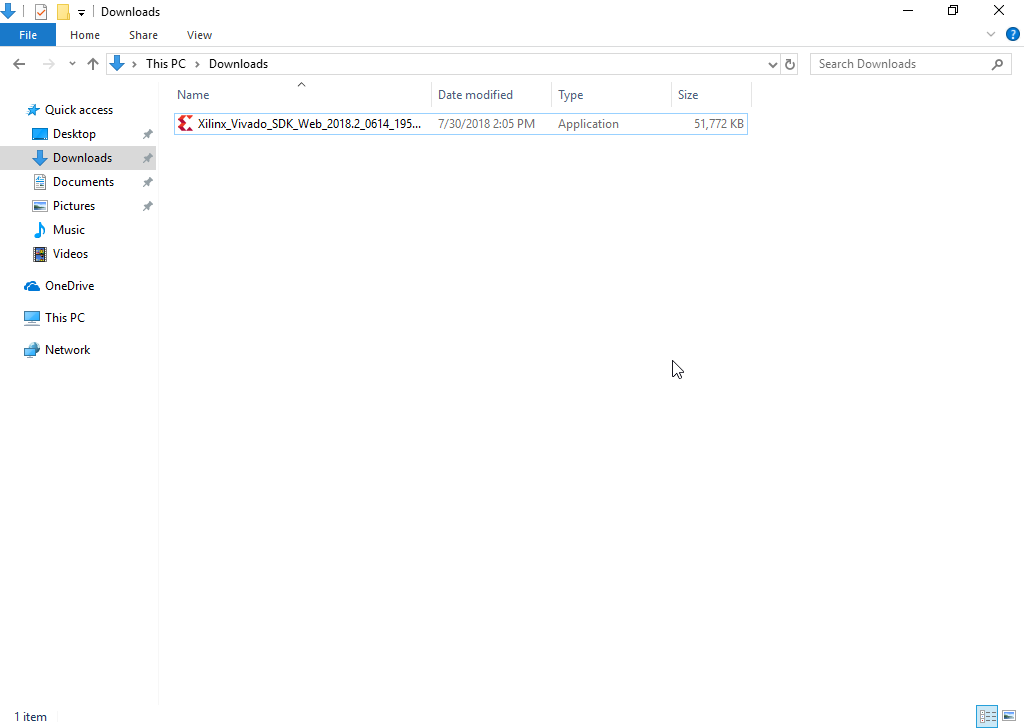
- Linux
-
Navigate to the directory that the installer binary was downloaded to in a final application, then enter the command beneath with the correct filename to execute it as a super-user:
chmod +10 <installer>.bin && sudo ./<installer>.bin
Notation: All use of Vivado in Linux should be done as a super-user.
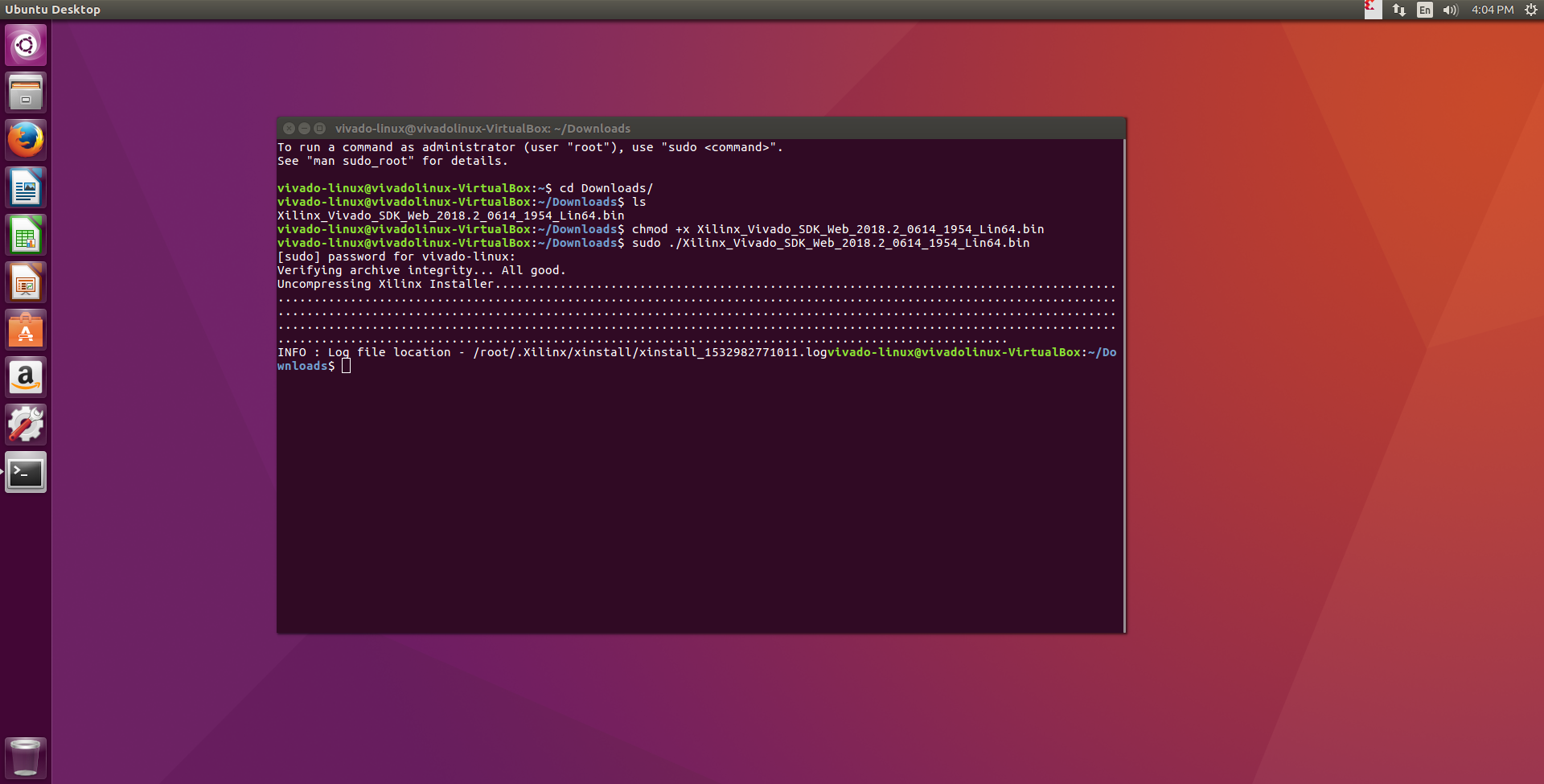
The rest of the steps in Section 1 are the same for both Windows and Linux.
At the Welcome screen, make sure that the operating system of the computer being used is listed in the compatibility listing, and so click Adjacent.
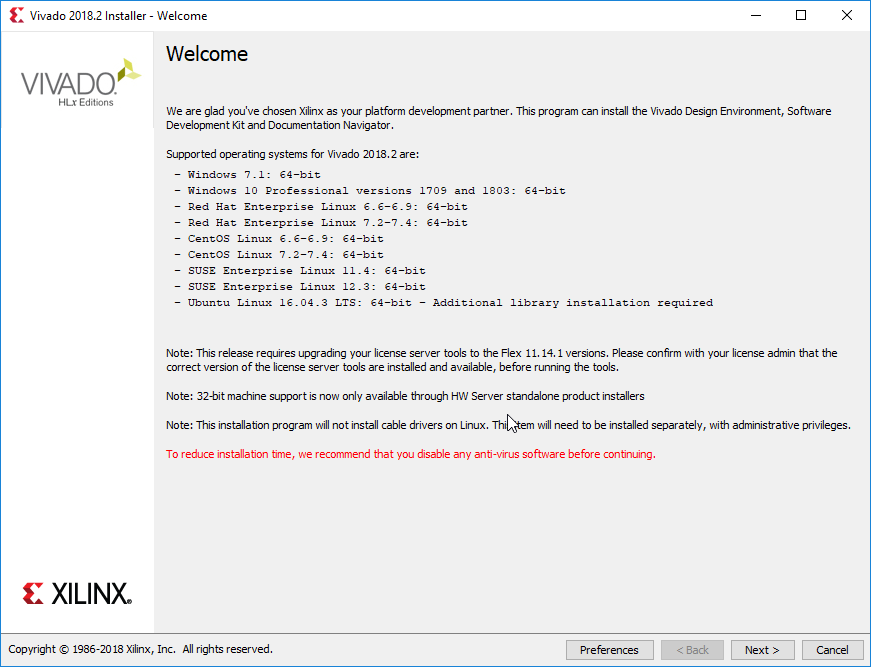
Use the same credentials as on the Xilinx website for user hallmark. Select the Download and Install Now choice and click Next.
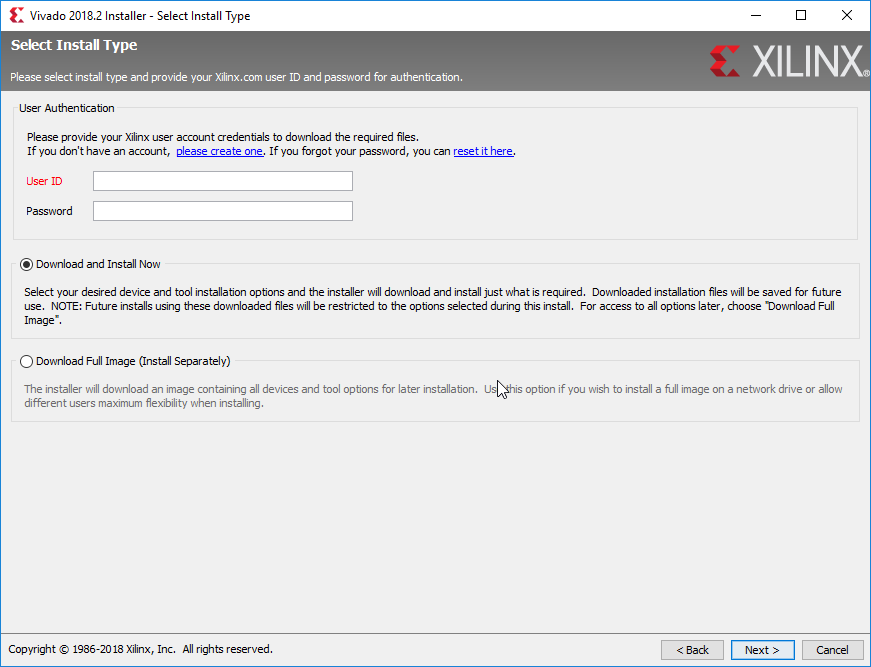
Read and accept all three license agreements, then click Adjacent.
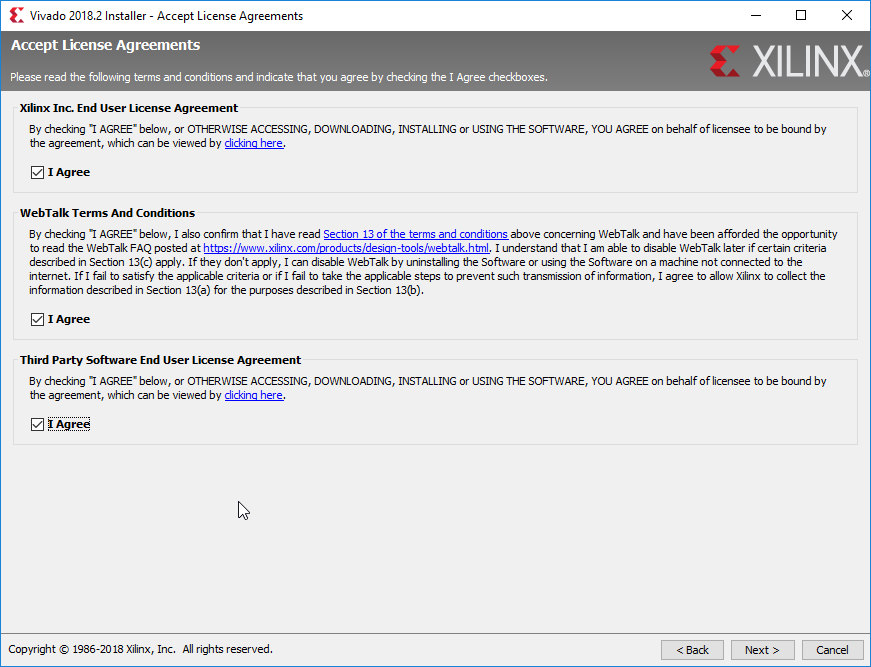
On the "Select Edition to Install" screen, several options are presented. Vivado WebPACK Edition is fully free, only will not work when developing for Digilent FPGAs that utilise a Kintex-7 or Virtex-7 role. Vivado Design Edition can be used without a license, and is the edition recommended by Digilent. A license is required to use Vivado Arrangement Edition. This guide does not cover the conquering and management of licenses. Select the most advisable edition for the situation, then click Next.

This screen provides more detailed options for the customization of the installation. The majority of these options do non need to exist changed for a basic installation, but unnecessary features can be removed to reduce the installation's footprint on the file-system - for instance, about users volition not need their Vivado installation to support Ultrascale, Kintex, or Virtex devices. The important options for a beginner to note here are described in the list below. Review the selections, then click Next.
-
Design Tools:
-
Vivado Design Suite:
-
Installs the chief Vivado development environment.
-
-
Software Development Kit:
-
Installs an Eclipse-based evolution environment for Microblaze and Zynq designs.
-
-
DocNav:
-
Installs a navigation tool to quickly find appropriate Xilinx documentation of IP and examples.
-
-
-
Devices:
-
Allows customization of the set of Xilinx FPGA parts that tin be designed for later installation.
-
-
Installation Options:
-
Install Cablevision Drivers:
-
Installs the advisable drivers and then that a connected FPGA can be programmed. If Vivado has not been installed before, make sure to check this!
-
-
Acquire or Manage a License Key:
-
Launches the Xilinx License managing director after installation is consummate. Virtually users practise not need to manage licenses.
-
-
Note: Changes can be made to the installation afterward it is complete by selecting Add Design Tools or Devices nether the Help card in the Vivado toolbar.
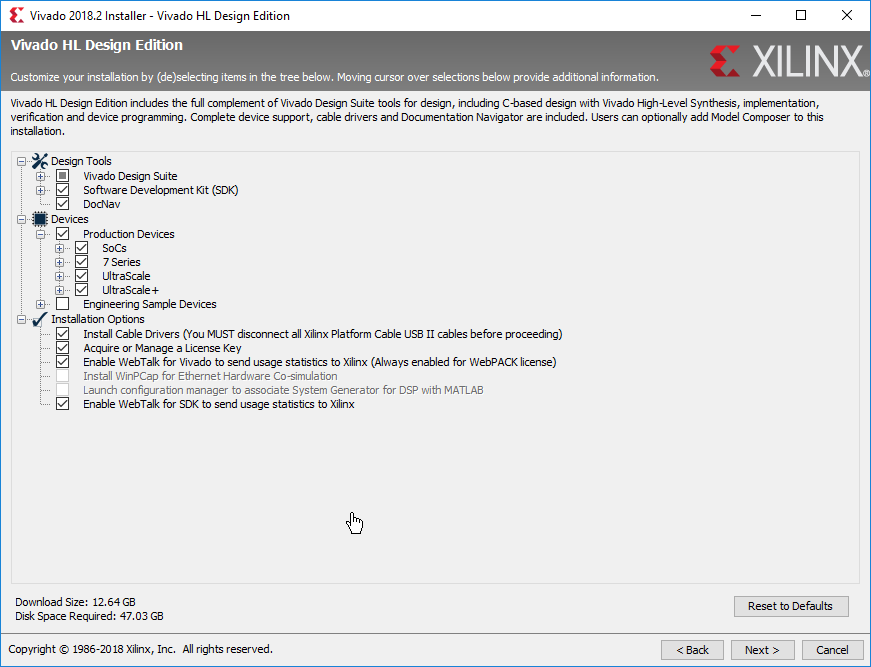
The "Select Destination Directory" screen shows how and where the installation will be placed in the reckoner's file system. Leaving all of these settings every bit default is typically fine. Click Next and then Aye if prompted to ostend that the installer will be creating a new directory.
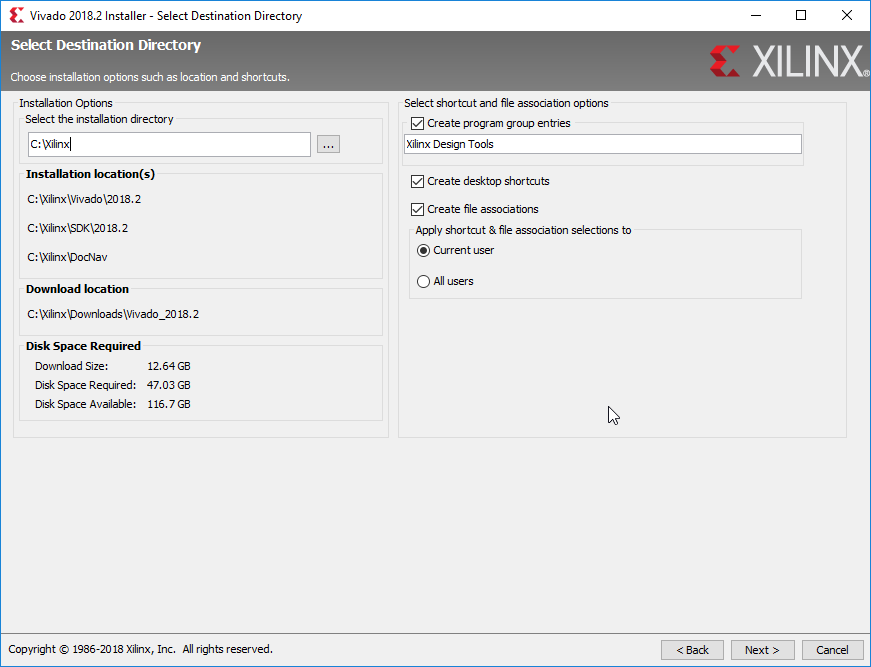
Review the "Installation Summary", then click Install.
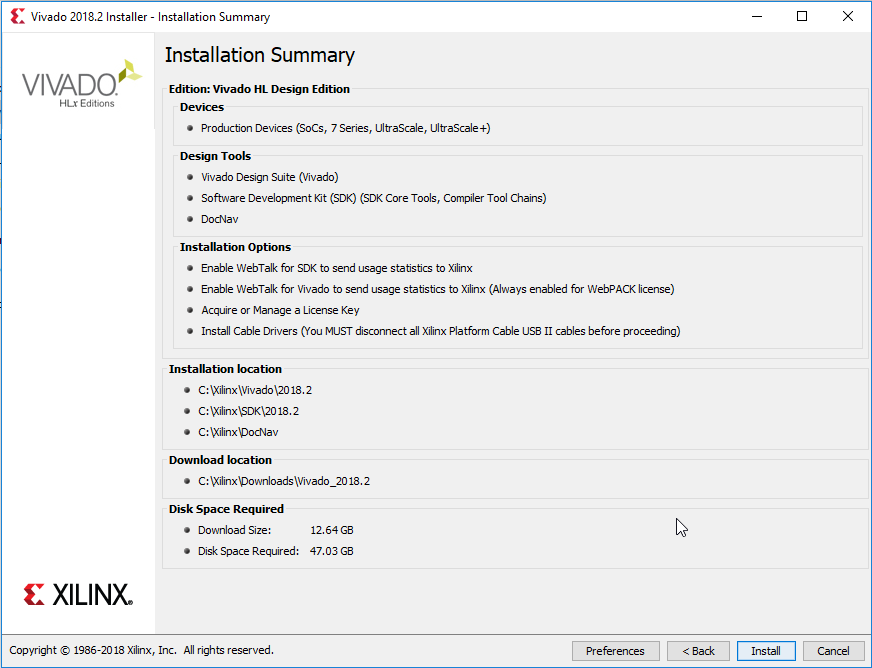
The installation procedure will have quite a while, potentially more an hour. Detect something else to work on until it completes.
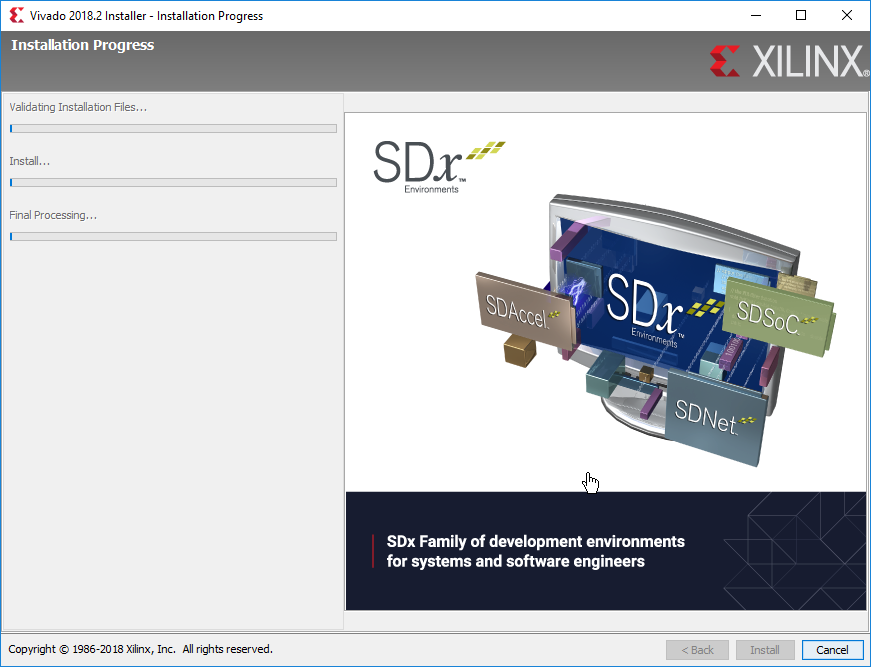
Vivado is at present successfully installed! If the "Acquire or Manage a License Cardinal" box was checked in Step i.7, the Vivado License Manager will launch. The bulk of users will non demand a license to employ Vivado, then the License Manager can just be closed.

2. Installing Cable Drivers on Linux
Windows users may skip this section and continue on to Footstep iii.
The Vivado installer does non install the USB drivers required to recognize an FPGA on a Linux organisation, regardless of whether the selection was checked or not. In order to install these drivers, navigate to the Vivado installation's data/xicom/cable_drivers/lin64/install_script/install_drivers/ directory in a panel window. The Vivado installation directory is typically the /opt/Xilinx/Vivado/*/ directory - the "*" representing the Vivado version number (2018.2, for example). From within this directory, run the ./install_drivers control as a super-user. Once this command completes successfully, the required drivers will exist installed.
Note: Some older versions of Vivado may require that the install_drivers command be extracted from a TAR file before utilize.
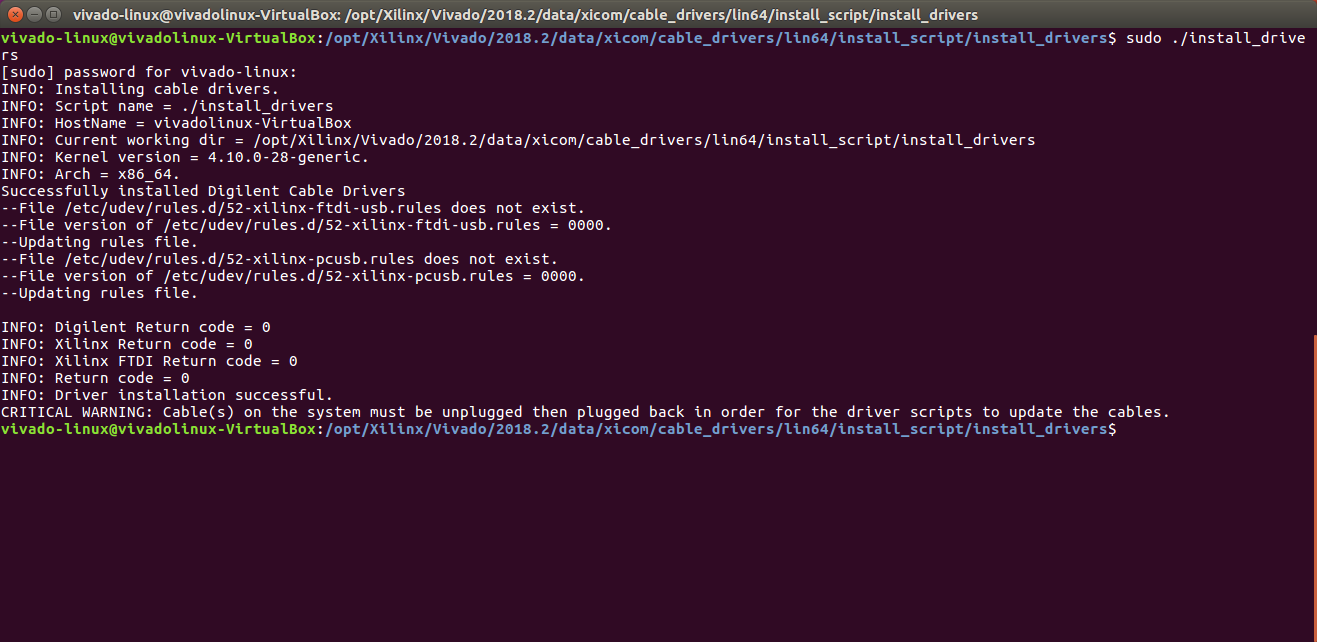
In club to use the USB drivers with a serial final, each user that volition be using serial terminals must be added to the dialout group. Serial terminals can be very useful for debugging FPGA designs that implement a USB-UART controller. A user can be added to the dialout group with the sudo adduser $USER dialout control. Note that this only adds the user that is currently active. In lodge to add a not-super-user while authenticated as root, use the command adduser <username> dialout instead, with "<username>" replaced with the name of the user to exist added.
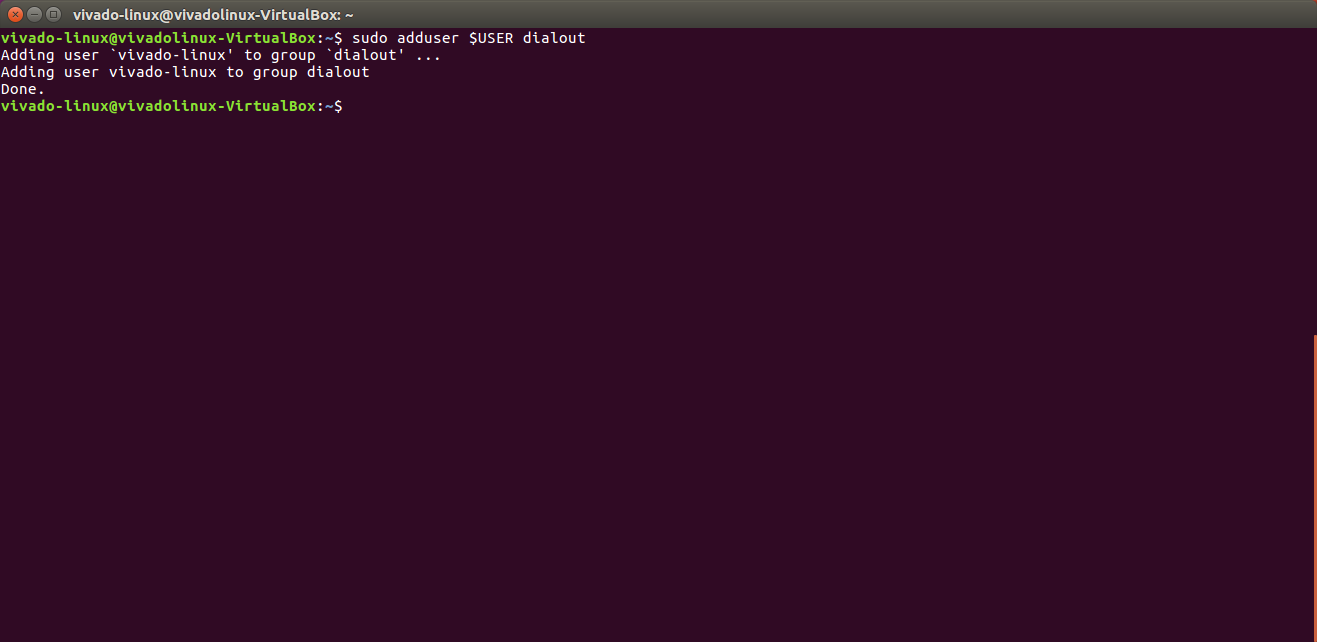
3. Installing Digilent Board Files
Digilent provides board files for each FPGA development board. These files make it easy to select the correct part when creating a new project and let for automated configuration of several complicated components (including the Zynq Processing System and Memory Interface Generator) used in many designs.
The lath files will be copied into your version of Vivado's installation directory. At the end of this department, an alternate method of installation is presented, which users familiar with git may find more convenient.

Open up the folder extracted from the archive and navigate to its new/board_files folder. You will be copying all of this binder's subfolders.
Note: When installing Vivado versions 2014.four or older, use the files establish in 'erstwhile/board_files' instead.
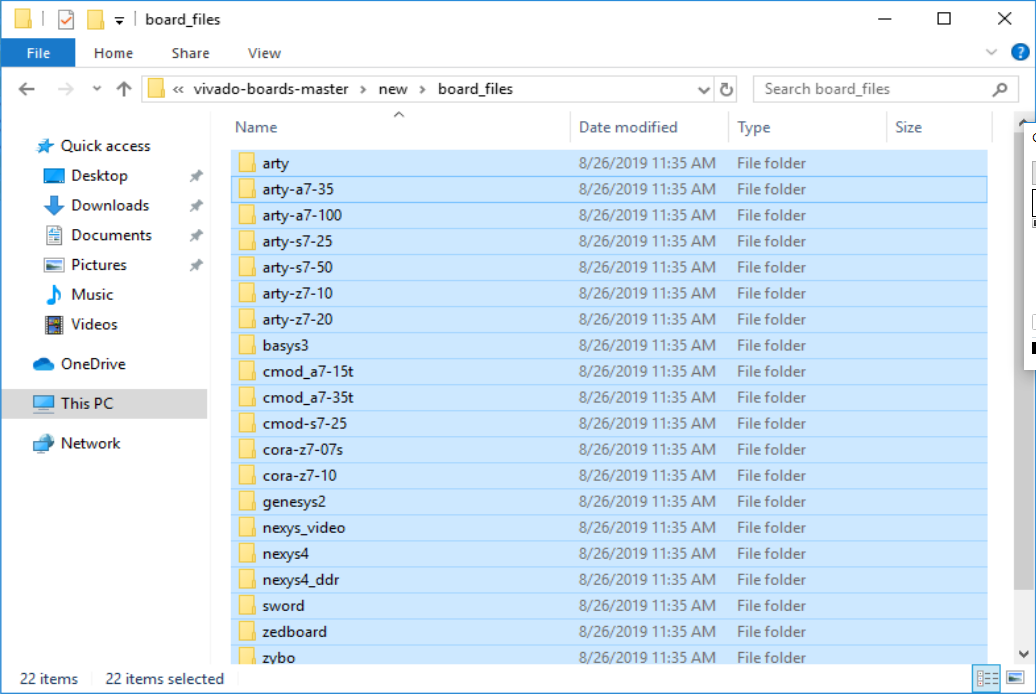
Open the folder that Vivado was installed into - C:/Xilinx/Vivado or /opt/Xilinx/Vivado by default. Under this folder, navigate to its <version>/data/boards/board_files directory. If this folder doesn't exist, create it.
Copy all of the folders found in vivado-boards' new/board_files folder, then paste them into this folder.
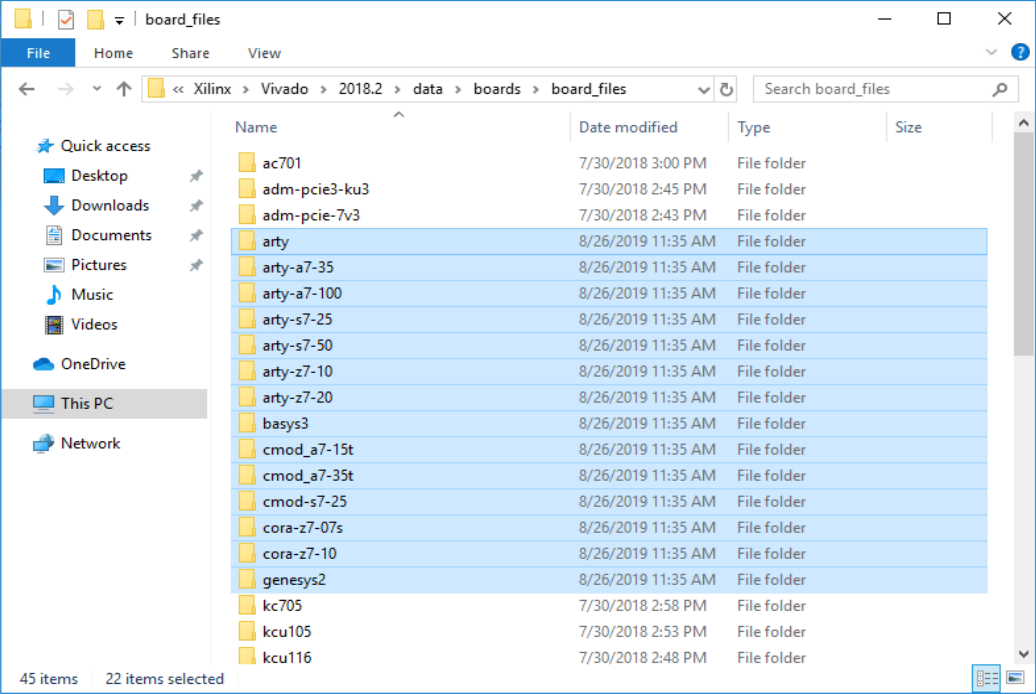
- Appendix: Installing the Board Files via the "vivado-boards" Github Repository
- You might want to use this method instead if you are familiar with git and want to have a clean way of pulling in the latest changes to the board files, without needing to manually copy-paste the files into every newly-installed version.
Download the Null archive of the Digilent's "vivado-boards" Github repository and extract it into a memorable location where it can stay. Alternatively, y'all can utilize git and a control prompt to clone the repository into the current working directory with the command
git clone https://github.com/Digilent/vivado-boards.
Find the file "Vivado_init.tcl" in the "utility" subdirectory of the vivado-boards repo. Copy and paste it into the
%APPDATA%/Xilinx/Vivado/directory for Windows or$HOME/.Xilinx/Vivado/(after authenticating as superuser) in Linux. This file is a script that will be run whenever Vivado is launched. Information technology volition load Digilent'south board files for employ in Vivado from the directory they were extracted into.Annotation: You tin also detect the path to this directory by launching Vivado and, before irresolute directory, running the
pwdcommand in the Tcl Panel.Note: The script init.tcl should be used instead of Vivado_init.tcl for Vivado versions 2016.four and older. If multiple versions of Vivado from before and after 2016.iv are installed, both scripts should used.
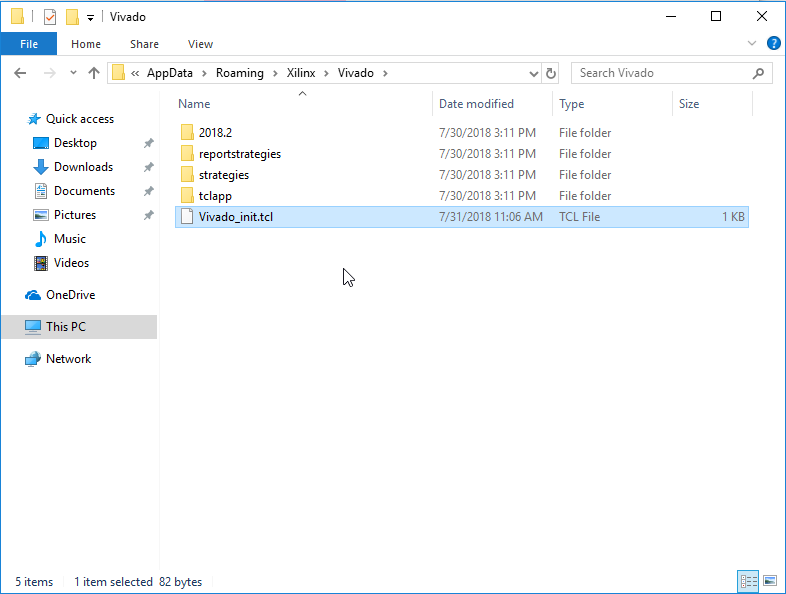
Open the copied init script in a text editor. Change the text
<extracted path>in the script to the path to the extracted vivado-boards folder. Save and close the file.This script sets the board.repoPaths parameter to a fixed path. The script is run whenever whatever version of Vivado is launched, and the parameter for that version of Vivado will remain set after you are done with your session. This means that by installing the script, you are setting the lath file repo for every version of Vivado you are using, and the changes will remain even after the script is potentially deleted in future. You lot can always clear the parameter subsequently with the command
set_param board.repoPaths "", again, this persists between sessions.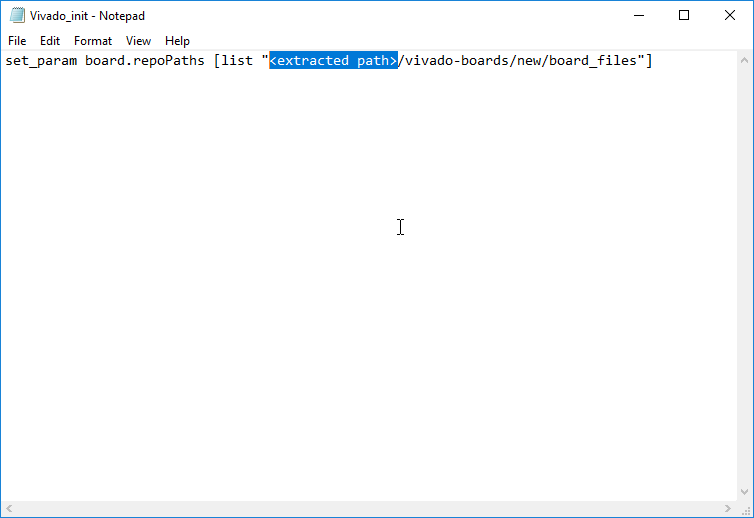
In Decision
With Vivado, Xilinx SDK, and Digilent's lath files installed, you lot are ready to get-go developing FPGA projects! To start learning how to utilize Vivado, check out 1 of the tutorials below:
Source: https://digilent.com/reference/programmable-logic/guides/installing-vivado-and-sdk
Posted by: cliffordbutertench.blogspot.com


0 Response to "How To Change Direct Map To 2 Way Associative Cache Vivado"
Post a Comment